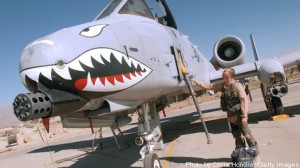
Integrity? We don't need no stinkin'integrity!
Precision Munitions Lessen Need for Close Air Support Plane: Schwartz Answers the A-10 Question
PENTAGON: One of the longest-running debates between the Air Force and the Army centers on close air support. Historically, the Air Force hates supplying CAS and doesn't like buying or maintaining the planes that do it. But the white scarf boys wouldn't let the Army do the job either, since it involved fixed-wing aircraft and shooting and that's what the Air Force does.
So when the Air Force announced it was scrapping a large chunk of the current A-10 Warthog fleet and the pilots who go with it — five squadrons worth — the Pentagon's back channels quickly filled with disgusted comments about how “there goes the Air Force again.” Every time they need to cut money from the budget the first thing they do is cut the A-10s, which have provided superb close air support ever since they started flying in the mid-70s, critics said. Two things make the A-10 especially fine at CAS: its amazing 30mmm cannon which can destroy a tank with ease; and the titanium bucket within which the pilot sits. The armored aircraft provides pilots with great protection, allowing them to be almost cavalier as they operate in dangerously kinetic environments.
 On top of those attributes, the A-10 can fly low and slow with great stability, operate in nasty places, take a lot of damage and keep flying, be easily maintained and is just really well designed to do its job. But, you can hear Army guys saying, it's not a fighter and traditionally works closely with the Army so the Air Force doesn't like it.
On top of those attributes, the A-10 can fly low and slow with great stability, operate in nasty places, take a lot of damage and keep flying, be easily maintained and is just really well designed to do its job. But, you can hear Army guys saying, it's not a fighter and traditionally works closely with the Army so the Air Force doesn't like it.
Well, the current Air Force Chief of Staff, Gen. Norton Schwartz belies that traditional Air Force image. He's a veteran special operations guy. He bleeds at least as much purple as he does blue (translation: he strongly supports joint operations). He has wholeheartedly pushed the service to open its mind and arms to Unmanned Aerial Vehicles and often publicly praises Air Force personnel who fight on the ground in unconventional Air Force jobs.
Given the important cultural, operational and symbolic implications of cutting the five A-10 squadrons, I asked Schwartz today how he could justify slashing the fleet. First, he pointed to fact that 246 A-10s will remain in Air Force service. “The bottom line is, as remarkable as the A-10 is, it isn't the only machine that does close air support,” Schwartz told reporters at a briefing this afternoon. He mentioned the B-1 and B-52s as delivery platforms, which may seem weird to some ground huggers, but the fact is that precision guided munitions allow planes flying a great heights and great speeds to deliver highly precise and devastating attacks against ground forces. Of course, they often depend on ground-based tactical air controllers to deliver those munitions, but they are effective.
On top of that, Schwartz and Air Force Secretary Mike Donley made clear that the service has made a strategic decision to use multi-role aircraft as much as possible. The Warthog has one main role.
In other news, the Air Force released a paper today detailing some more budget cuts before the Feb. 13 rollout. The C-130 Avionics Modernization Program will be canceled and replaced with a much more modest program.
Altogether the service will eliminate more than 280 aircraft over the next five years: 103 A-10s, 21 older F-16s, 27 C-5As, 65 C-130s, 20 KC-135s, 21 C-27s and 18 Global Hawk Block 30s and 11 RC-26s.
Finally, it will rebuild 350 F-16s (a Service Life Extension Program) to help bridge the gap created by the slowdown in F-35A production caused by concurrency.



